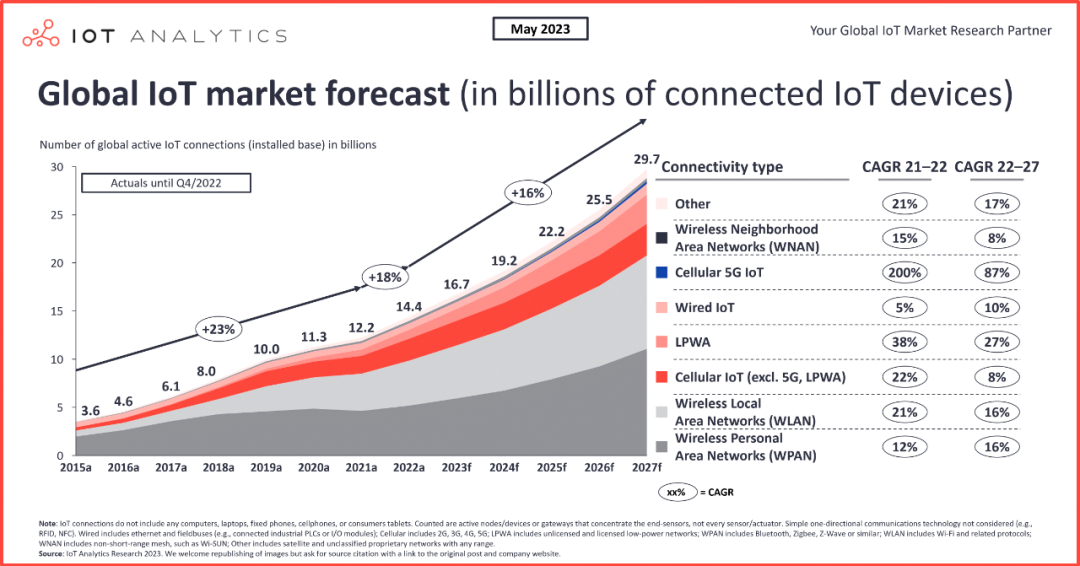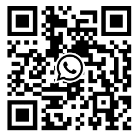Recently, market research firm IoT Analytics released a report summarizing the 2022 IoT market and predicting its future, providing insights into multiple aspects of the Internet of Things. The report shows that the number of global IoT connections has increased by 18% to 14.3 billion in 2022, and is expected to grow by 16% in 2023, ultimately reaching 16 billion connections. In the coming months, this 16% growth rate, or nearly 2.3 billion new IoT devices, will constitute the source of IoT industry growth.

Clear pattern of IoT connectivity: Three types of connectivity technologies account for 80% of the market share
Although there are many connecting methods behind the Internet of Things, after years of development, there are still a few technologies that have formed large-scale applications. According to IoT Analytics' tracking data, global IoT connectivity is dominated by three key technologies, namely WiFi, Bluetooth, and cellular networks, which account for nearly 80% of the total number of IoT connections supported by these three technologies.
Firstly, let's take a look at the situation of WiFi. According to IoT Analytics, WiFi accounts for 31% of all IoT connections. WiFi technology and devices are also constantly evolving. In 2022, more than half of the world's WiFi devices are based on the latest WiFi 6 and WiFi 6E technologies, which are expected to achieve faster and more reliable wireless connections, continuously improving communication efficiency between IoT devices in corresponding scenarios, improving user experience and overall performance. In all IoT scenarios, WiFi technology is leading IoT connectivity in fields such as smart homes, smart buildings, and healthcare.
Bluetooth technology has grown into the second largest market for IoT connectivity, with IoT Analytics data showing that 27% of IoT connectivity worldwide relies on Bluetooth. Among them, low-power Bluetooth (BLE) has been evolving and developing, continuously reducing device energy consumption while maintaining reliable connectivity. Currently, BLE has become the preferred choice for battery powered IoT devices such as smart home sensors and asset tracking devices. Even IO Link wireless technology in the industrial field is showing increasing interest in Bluetooth, allowing wireless communication between sensors/actuators and I/O hosts.
WiFi and Bluetooth have relatively short transmission distances, and among long-distance IoT connection technologies, cellular IoT accounts for the highest proportion. According to IoT Analytics data, the cellular Internet of Things (including 2G, 3G, 4G, 5G, LTE-M, and NB IoT) currently accounts for nearly 20% of global IoT connections. In 2022, global cellular IoT connections increased by 27% year-on-year, greatly exceeding the growth rate of global IoT connections. This growth is due to the large-scale adoption of technologies such as LTE-M, NB IoT, LTE Cat 1, and LTE Cat 1 bis, which, of course, is backed by the global withdrawal of 2G and 3G networks. IoT Analytics mentioned that although the shipment volume of 5G modules increased by over 100% year-on-year in 2022, the growth rate is still lower than many people's expectations.
The cellular Internet of Things has shown a very significant head effect, with IoT Analytics data showing that the top five operators - China Mobile, China Telecom, China Unicom, Vodafone, and AT&T - manage 84% of global cellular Internet of Things connections. In terms of IoT revenue, the top five operators account for 64% of cellular IoT revenue, including China Mobile, AT&T, Deutsche Telekom, China Unicom, and Verizon.
The future performance of different IoT connection technologies is clearly differentiated
From IoT Analytics data, it can be seen that in the past 2021-2022, the growth rates of different connection technologies have varied greatly. Among them, 5G based IoT connections have the fastest growth rate, reaching a growth rate of 200%; Next is the Low Power Wide Area Internet of Things (LPWAN), with a growth rate of 38%; Next is the cellular Internet of Things, excluding 5G and LPWAN, with a growth rate of 22%. The author believes that this field is mainly driven by LTE Cat 1 and LTE Cat 1 bis; Wireless local area networks have achieved a growth rate of 21%, which is mainly dominated by WiFi.
IoT Analytics predicts that between 2022 and 2027, the growth rate of the Internet of Things based on 5G will still be far ahead, with a compound annual growth rate of 87%; Next is LPWAN, with a growth rate of 27%; Except for 5G and LPWAN, the growth rate of cellular IoT has decreased to 8%; Wireless local area networks and wireless personal area networks represented by WiFi and Bluetooth can guarantee a compound annual growth rate of 16%.
It can be seen that in the coming years, the proportion of long-distance IoT connections will continue to grow. Among them, due to the small base of 5G and the continuous acceleration of 5G applications in the coming years, the application scenarios based on 5G will not expand much and become one of the most active fields in the global IoT industry. Especially with the promotion of RedCap's commercial use, the scale of 5G based IoT connections will accelerate in the coming years; LPWAN remains one of the main forces in the Internet of Things. Against the current development background of various technologies in the Internet of Things, it is expected that there will be no corresponding technologies in the next few years that can replace the market position of NB IoT and LoRa; With the continuous decline in commercial and cost of RedCap, there has been a substitution for LTE Cat 1 and LTE Cat 1 bis.
Two obvious trends are worth paying attention to
Firstly, there is a clear trend towards the integration of various technologies in the low-power wide area Internet of Things.
LPWAN remains a hot topic in the coming years. In the past year, there have been two major mergers and acquisitions in the LPWAN field, shifting the field from previous technological competition to integrated development. These two events are UnaBiz's acquisition of Sigfox and Semtech's acquisition of Sierra Wireless.
After acquiring Sigfox, UnaBiz extensively collaborated with the LoRaWAN and cellular network camps to promote the integration of different connectivity technologies. This means that UnaBiz is no longer just a technology provider, but a solution provider, bundling all different technologies together and coordinating them on its own software platform.
In addition, Semtech itself is the owner of LoRa technology, and its acquisition of Sierra Wireless is a former global leader in cellular IoT modules and platforms. Semtech's next important task is to promote the deep integration of LoRa and cellular IoT, as well as the operation of the platform.
The second is the accelerated application of low orbit satellite IoT
IoT Analytics also lists "other" connection technologies, and the IoT of low orbit satellites is a typical representative of "other".
With the growth of the scale of the Internet of Things, the demand for ubiquitous connectivity among users is also increasing. In scenarios where ground networks were previously unable to connect, low orbit satellites provide a very effective way, and this technology is particularly useful in agriculture, maritime, and logistics industries. Low orbit satellites are closer to the Earth than traditional satellites, thereby reducing latency and improving data transmission speed, which is crucial for real-time data processing. In the view of IoT Analytics, this type of connection is more resilient and reliable, ensuring consistent communication even in challenging environments or natural disasters.
IoT Analytics analysis shows that the number of satellite IoT connections is expected to increase from 6 million to 22 million between 2022 and 2027, with a compound annual growth rate of 25%. Although the 22 million connections have a small impact on the overall market, some companies are starting to integrate satellite connections into chips, which will significantly accelerate the application of satellite IoT. For example, Qualcomm has partnered with satellite operator Iridium to provide satellite emergency information services for smart phones equipped with Snapdragon chips; In addition, Sony Semiconductor has released the first low-power cellular IoT chip ALT1350 that provides satellite connectivity, opening up new possibilities for IoT devices to communicate beyond traditional network boundaries. This approach of integrating satellite connectivity into LPWA chips is expected to drive further innovation and growth in the satellite IoT market. Of course, in my opinion, satellite IoT is still a supplement to ground IoT connectivity and can play a role in some vertical fields, but it will not replace the existing cellular IoT market.
IoT Analytics also conducted research on a large number of enterprises, and the research results showed that despite some macro uncertainties, the IoT market will remain basically intact in the second half of 2023, with positive sentiment dominating the market.
References:
1. IoT Think Tank
Contact: Qui
Phone: 18146178586
Tel: 18146178586
Email: qui@zonewu.com
Add: 1501-3, Building F03, Phase III, Software Park, Jimei District, Xiamen City, Fujian Province, China
